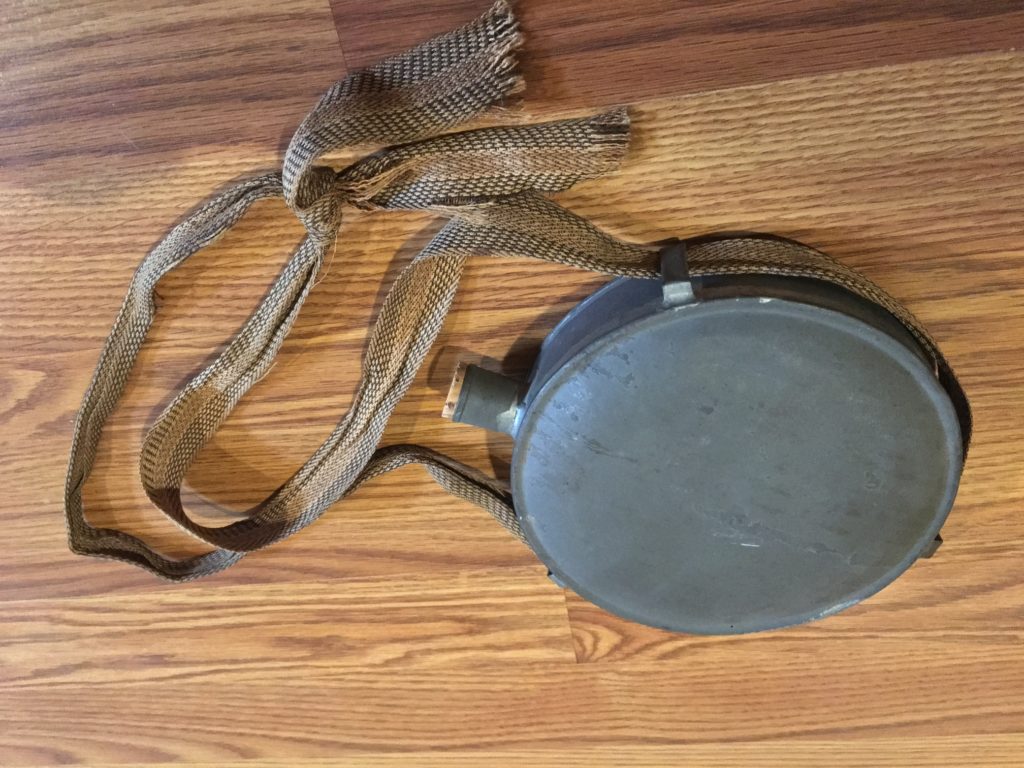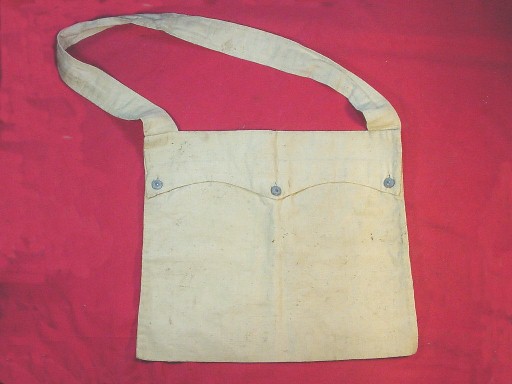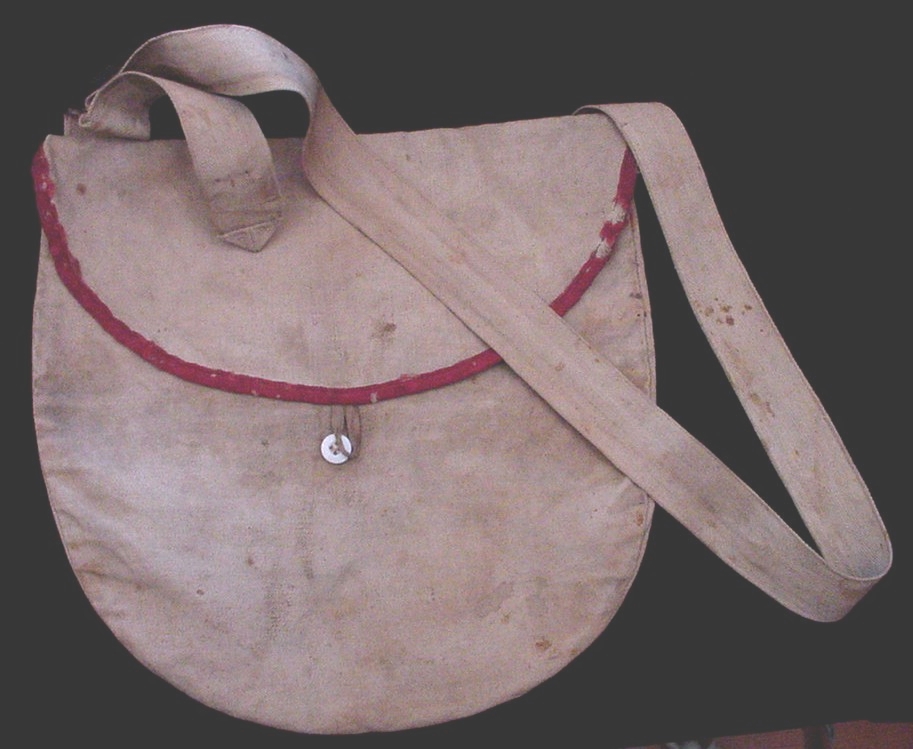WAS THERE A CHRONIC SHORTAGE OF HAVERSACKS & CANTEENS
AMONG WESTERN CS CAVALRY?
OR
WAS IT A SHORTAGE BY “CHOICE”?
By Ken R. Knopp
(Second in a series of articles on Confederate Cavalry arms and equipment exclusively for the Camp Chase)
Official inspections taken of Confederate cavalry during the war are incredibly revealing as to the arms, saddlery, accoutrements, ammunition and other equipment found in the ranks. From them, we can learn a lot about what was actually used in the field. So, why are otherwise very necessary items like haversacks and canteens- that is, individual vessels to hold food and water, habitually in short supply in the inspection reports for virtually every western cavalry command? This discrepancy is also found to some slightly lessor degree in the records of eastern (ANV) cavalrymen but the question remains simply- Why? This question is important as it may well illustrate a case of our modern historical mis-understanding of the Confederate cavalryman’s daily existence and perhaps, to highlight yet another flagrant reenactor “disconnect” in accurate equipment. To illustrate the issue lets look at the inspection reports.
NOTE: This study was taken from a cross section of six inspection reports that were chosen because each encompasses a very significant and/or large portion of the primary western cavalry in the field at different time periods and, they were also some of the most complete reports available. Nevertheless, they are statistically consistent with all of the other reports available for western cavalry.
For a relative historical perspective, the data below represents items found in each command and their percentage (%) to “effective” men. Effective men equates to those present at the time of the inspection report (mounted and dis-mounted) and able to take the field. Not included are the sick (present or absent), others absent and on leave.
1. August 1863 inspection of Brig. Gen. Chalmer’s Cavalry (two Brigades, approximately 1,247 “effective” men). One of the earliest, most detailed reports on western cavalry available. With most of the Army of Tennessee cavalry in Georgia, Gen. James Chalmers had recently been assigned to the cavalry in north Mississippi to guard that vital granary region. 1.
Chalmer’s Cavalry 1,247 519 42% 312 25%
2. In January 1864, much of the west’s cavalry was with the Army of Tennessee in Georgia and east Tennessee under Gen. Joe Wheeler. The remainder was in Mississippi in the Army of the West. This “Year End Inspection Report” details the weapons, accoutrements, ammunition and horse equipment for the cavalry commands of that army. Various sources suggest about 10,800 effective cavalrymen. The government had recently consolidated some of these commands under S.D. Lee and N. B. Forrest but each one is noted separately in this report. Other cavalry in the Army of the West was widely scattered in Mississippi and Alabama under various independent commanders and also included. 2.
Forrest 2,500 1,500 60% 1,759 70%
Richardson 1,000 794 80% 756 75%
Ross 900 700 78% 360 40%
Cosby 900 529 59% 576 64%
Adams 900 280 31% 609 68%
*Greer 555 555 100% 555 100%
Chalmers 2,200 1,594 72% 1,689 77%
Ferguson 1,900 899 47% 926 49%
TOTAL: 10,855 6,851 66% 7,230 68%
*The inspection report of Greer’s cavalry tells us this unit was fully armed and equipped but with no details. While this is doubtful and begs further questions it must be accepted at face value.
**Effective men are estimations based upon various sources.
3.A month prior to the Battle of Brice’s Crossroads, the Confederate War Department ordered an inspection of Forrest Cavalry Corps which by that time, comprised a major portion of the west’s cavalry. Dated May 26, 1864, it was the most complete report of Forrest’s Cavalry during the war. He was at his peak in horses (9,500 serviceable) and men, recently recruited to three divisions with a combined strength of 8,952 effectives plus artillery and his Escort (about 65 men). This very detailed report comprises his entire command including his artillery (sixteen guns) and the Divisions of Chalmers, Buford and, Gholston’s Brigade of Mississippi State Troops totaling some twenty-nine regiments and battalions. Forrest had recently returned from his west Tennessee raids including actions at Jackson Tenn, Paducah Ky., etc. and significant engagements at Ft. Pillow and against Sooy Smith at Okalona, Miss., etc. In these endeavors he had gathered a large number of conscript men, captured horses, weapons, equipment and supplies. In addition, since Dec. 1863, Forrest had made a number of requisitions on the Ordnance Department for arms and equipment which yielded 1,350 imported French Lafoucheaux pistols, at least two thousand Austrian Lorenz rifles, saddlery and, some “accoutrements” from Richmond. 3.
Chalmer’s Div 4,067 1,842 45% 1,437 40%
Buford’s Div. 3,615 1,503 42% 1,572 43%
Gholston’s 1,213 245 20% 257 21%
TOTAL: 8,895 3,590 40% 3,266 37%
4. After the remarkable success by Forrest at Brice’s Crossroads, the resulting capture of Federal arms and equipment certainly augmented supply to a great degree. To illustrate an interesting comparison point, we turn to an inspection report of Rucker’s Brigade of Chalmer’s Division dated July 3rd, 1864 as a relative sample of what then might be typically found throughout Forrest’s Cavalry. 4. Consisting of 1,072 effective men from three regiments of Tennessee and Mississippi cavalry we find the following:
Chalmer’s (2nd Brigade) 1,072 496 46% 675 63%
*1st Brigade (Neely’s) detached and not included.
Now, compare the percentages of Chalmers’ May report to the July report. Keep in mind that at the Battle of Brice’s Crossroads some two weeks prior Forrest’s men had captured 17 cannon, 250 wagons, 3,000 stands of arms, killed and wounded some 2,000 men and captured another 2,000 men. 5. Not noted in Forrest’s battle report but obvious would be the assumption of the many, many haversacks and canteens that were part of these captures. Combine this with the many more captures of these articles in the previous engagements noted above and Forrest’s equipment requisitions made upon Confederate authorities from January through June of 1864. As a result, one should be able to reasonably assume with confidence that haversacks and canteens should be plentiful and not likely an item in short supply in Forrest’s command, right? Nevertheless, it is interesting to note that despite all of the above one still finds the percentage of haversacks virtually the same and canteens only marginally higher in the Chalmer’s July inspection report. But WHY????
5. About this same time, the west’s other large cavalry command was with the Army of Tennessee under Gen. Joe Wheeler. All through the spring and summer of 1864 Wheeler’s cavalry fought almost incessantly. Despite potential supply sources such as engagements with the Federals and their close proximity to the arsenals at Atlanta, Augusta and Macon this extremely detailed report of Wheeler’s Cavalry Corps (taken July 31, 1864) shows the number of haversacks and canteens on hand but again, significant shortages are noted. 6.
Wheeler’s Cavalry Corp’s 6,734 3,228 47.9% 4,120 61%
6. Wheeler’s Cavalry, Jackson’s Division, Plametto Ga. September 20, 1864. Unlike the other reports, this was an official Adjutant Inspector General Office report highlighting equipment “deficiencies” which meant those in extremely poor condition requiring replacement or a complete lack thereof. To be consistent, the numbers shown below are those on hand to effective men in the ranks. 7.
Armstrong’s Brigade 1,513 653 43% 1,138 75%
Ross’s Texas Brigade 845 All Deficient *
Ferguson’s Brigade 1,984 709 72% 659 67%
Wheeler’s Reserve Corps 656 431 66% 506 77%
Lewis’ Mtd. Ky Inf. Brig. 473 232 49% 321 68%
Hannon’s Ala. Brigade 241 141 58% 215 89%
TOTAL: 4,712 2,166 46% 2,839 60%
* Noting that no haversacks or canteens are mentioned in Ross’s report probably suggests very few and in poor condition rather than a complete void.
For certain, throughout much of the war there was never a full compliment of canteens and haversacks in the western cavalry commands. Although we can speculate, there is no clear reason why they are not found in greater numbers. There are however, questions to ponder:
-Can we assume an anomaly in the Inspection Reports? While the inspection reports are somewhat sporadic in the units that were inspected, the number of reports and time periods, they are all thoroughly consistent in the premise of an inadequate number of haversacks and canteens. So, are we talking about inaccurate or inconclusive inspection reports? Doubtful, too many.
-Can we say that the Inspection Officers only noted “Confederate government issue” items? Possibly, but considering the Federal captures and with a large number of haversacks made by civilians on the Confederate commutation system would they not apply that same logic to identify other Federal and civilian arms, equipment, saddles, bridles, clothing, shoes, etc. in the ranks? Why are these abnormalcies not noted anywhere in the reports, in the Inspector’s “remarks” or other contemporary records? Again, despite numerous reports no “official” ruling has been noted on this subject nor is there any consistency in reporting to justify that theory.
-Can we assume that the number of haversacks and canteens were inadequate due to a lack of access to supply sources such as captures? Given the access these commands had to the enemy and their multiple successful engagements and, with so many reports taken at different times by different inspection officers logic would tell us probably not. At least not any more than other probable captured items in the reports.
How about access to Confederate supply sources? While complete records are impossible to obtain those available suggest Confederate manufacture of these items was quite good.
A. Atlanta Ga. Arsenal: July 1, 1862 – June 30th, 1863 Rec’d & Purchased Issued 8.
Haversacks 42,889 67,834 Canteens 72,147 64,250
B. Macon Ga. Arsenal: “Stores on Hand”, March 1863 – Mid-Feb. 1864 * 9.
On hand at beginning of period Rec’d or Fabricated Issued
Haversacks: 1,356 3,263 3,618
Canteens: 9,641 4,425 12,996
* These are the only consistent records available from the Macon Arsenal. Interestingly, significant numbers of haversacks and canteens remained on hand in Macon for months with few or no issues suggesting demand was sporadic and not excessive.
C. Augusta Ga. Arsenal: Records are scant on these items but from Nov, 12, 1861 to Oct 23, 1864 one local contractor, George Wyman & Co. provided to the arsenal 30,565 haversacks and thousands of canteen straps. Other arsenal records note tin, cedar and cypress wood canteens being shipped. 10.
D. Columbus Ga. Arsenal: Again, records are scant but the huge textile mills in Columbus no doubt provided copious amounts of cloth for every need including haversacks allowing the arsenal to ship significant numbers throughout the war. In addition, the arsenal provided tin and cedar canteens to the stores of other arsenals for subsequent issue. 11.
Other manufacturing at places like Selma, Montgomery and elsewhere in the western Confederacy no doubt provided many more. While incomplete and therefore largely circumstantial, the manufacturing notes above strongly suggest Confederate production of canteens and haversacks was apparently adequate for the army’s needs. While transportation issues may have impacted issue to the cavalry, manufacturing was clearly not a problem.
So, how do we account for a clear lack of haversacks and canteens in the ranks of the cavalry? It is quite possible this obvious lack of a seemingly important item may well have been by “choice”. In other words, many of the west’s (and east’s) cavalrymen simply chose NOT to carry these articles. But why? Well, it is difficult to know for sure but, the mid-19th century was a different era and with a different mind set, so here are some theories:
-Mess Mates (usually 3-5 men plus servants) “shared” the preparation of meals requiring a reciprocal sharing of the responsibilities for carrying their utensils. Thus only a portion of the mess carried a haversack and a canteen. In the case of officers it is possible their servants carried their rations and maybe their canteens.
-Desire for traveling light and the “hassle factor” are excellent considerations. As for the haversack, it is known that prior to a raid or campaign when 3-4 days rations were ordered cooked, many of the men would consume their rations immediately or in a very short period. Often these men assumed that more rations would soon be captured, “forged” or otherwise provided when needed and so there was little urgency for carrying a haversack. Similarly, its possible the trooper just did not want the hassle of carrying the item so they put their extra rations in a tote sack, rolled them up in the blanket roll, valise or saddles bags or, their trouser’s pockets.
-What about canteens? Water is an absolute necessity! Since the cavalry routinely watered their horses out of necessity, could it be that the young, resilient or lazy trooper simply took his water at the same time? The ever useful tin cup was employed at streams or at a roadside well and that was considered adequate. Often troopers shared canteens among mess mates like other camp items. One story is told about a infantryman that would routinely give away any canteen he found to his “pards” under the condition that he could get a drink when he wanted. After giving away several canteens in this manner it was nothing for this lazy fella to stay thoroughly hydrated by moving among his many friends.
Perhaps it was “all of the above” or maybe, the real reason or “reasons” may always elude us. Whatever it is, it is clear on average only about 48% of western cavalrymen carried a haversack and 52% a canteen.
So, while carrying a canteen for safe hydration on the battlefield makes good sense, perhaps, reenactors should consider emulating our gallant heros a bit more in other ways such as…..
1. Forming a “mess” for sharing the cooking and carrying of utensils. Organize 3-4 other “like minded” guys. Not just for cutting travel costs but for improving your impression, to cook and eat with at events. Buy authentic foods then one or two carry a haversack, another the frying pan and other utensils, split the food, all carry an oil cloth to build your “she-bang” and then, “share” the experience. Just as they did!
2. Traveling light. Less stuff means less to buy, less to keep up with and fall apart, less weight on you and your horse and, more authentic! LESS IS BEST!
As cavalry reenactors, we should (within reason) strive to wear, use and ride the right stuff, travel, fight, eat, sleep and live the way they did- the “cavalry way”. What better way to capture the real experience? In short, we must ask ourselves, are we “reenactors” or, just “costumed campers”?
-30-

Canteen used by member of 3rd Alabama

Confederate Canteen

CS canteen ….H. Love owner marked.

Confederate made Haversack

CS made and used Haversack

CS officers Haversack, owned by Maj. James Eustis on the staff to Gen. Joe Johnston. This has pillow ticking interior lining. These were special order items often made by company saddlers or other skilled leather workers, from local merchants or sometimes through the arsenals then embellished to personal tastes.
FOOTNOTES:
1. Ordnance Return by Lt. John T Buck, August 1863 of Fifth Military District, Dept. of Miss and East Louisiana, Chalmer’s Cavalry, Hdqrtrs. Grenada Miss. Original report found in the service file of J.T. Buck, Ordnance Officer to Gen. James Chalmers, National Archives Military Service Records, General and Staff Officers, Micro film M331, National Archives, Wash. D.C.
2. Kennard to Gorgas, Jan. 1, 1864, Year End Inspection Report, Army of the West, Ordnance Records, Mississippi Archives, Jackson Miss. Year end report sent by Col. Jassel M Kennard, Chief of Ordnance, Army of the West to Col. Josiah Gorgas, Chief of Ordnance in Richmond, Va. Includes Inspection Reports of the entire Army of the West including cavalry under Forrest, Ross, Chalmers, Ferguson, Wirt Adams, Cosby, Jackson and others.
3. Maj. George B Hodge, Inspection Report of Forrest’s Cavalry Corp’s, May 26, 1864, Inspection reports and related records, Inspection Branch, Adjutant and Inspector Gen’ls Office, Roll #4, M935, National Archives, RG 109, War Dept Collection of Confederate Records.
Sources for the above include the OR’s and author’s copies of original correspondence and requisitions from the Mississippi Archives, Jackson Mississippi.
4. Inspection of Chalmer’s Division by James Overton Jr. AAIG, Quartermaster Brig., July 3rd, 1864, at Verona Miss. Inspection Reports and Related Records, Inspection Branch, Adjutant and Inspector Generals Office, Roll #4, M935, National Archives, RG 109, War Dept Collection of Confederate Records.
5. OR’s., Correspondence, Ky, SW Va, Tenn., Miss., Ala., and N. Ga. Chapt LI, Vol. 39, Pt 1 Pgs.226-229
6. Consolidated Monthly Report of Ordnance and Ordnance Stores, July 31, 1864, By S.P. Kerr, Chief Ordnance Officer, Wheeler’s Corps Cavalry. Original report found in the service file of S.P. Kerr, Ordnance Officer to Gen. Wheeler, National Archives Military Service Records, General and Staff Officers, Micro film M331, National Archives, Wash. D.C.
7. Inspection of Jackson’s Division, AAIG, Quartermaster Brig., Sept. 20th, 1864, at Palmetto, Ga. Inspection Reports and Related Records, Inspection Branch, Adjutant and Inspector Generals Office, Roll #4, M935, National Archives, RG 109, War Dept Collection of Confederate Records.
8. Wright to Gorgas, June 30, 1863, Atlanta Arsenal Year End Report, Atlanta Arsenal Records, Records of the Ordnance Bureau, Chapt IV, Vol. 8, National Archives, RG 109, War Dept Collection of Confederate Records.
9. Cuyler to Gorgas, Macon Arsenal Correspondence, Vol. 58, Records of the Ordnance Bureau, Chapt IV, Record Group 109, National Archives.
10. List of Stores received at the August Arsenal, Vol. 34, Records of the Ordnance Bureau, Augusta Arsenal, Chapt IV, Record Group 109, National Archives.
11. Humphreys to Gorgas, May 1862- March 1865, Records of the Ordnance Bureau, C olumbus Ga. National Archives. Chapt IV, Record Group 109, Correspondence of the Chief of the Bureau of Ordnance.